Great disnub dirhombidodecahedron
| Great disnub dirhombidodecahedron | |
|---|---|
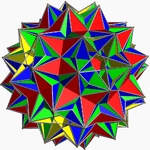 | |
| Type | Uniform star polyhedron |
| Elements | F = 204, E = 360 V = 60 (χ = -96) |
| Faces by sides | 120{3}+60{4}+24{5/2} |
| Wythoff symbol | | (3/2) 5/3 (3) 5/2 |
| Symmetry group | Ih, [5,3], *532 |
| Index references | U-, C-, W- |
| Dual polyhedron | Great disnub dirhombidodecacron |
| Vertex figure |  (5/2.4.3.3.3.4. 5/3.4.3/2.3/2.3/2.4)/2 |
| Bowers acronym | Gidisdrid |
In geometry, the great disnub dirhombidodecahedron, also called Skilling's figure, is a degenerate uniform star polyhedron.
It was proven in 1970 that there are only 75 uniform polyhedra other than the infinite families of prisms and antiprisms. John Skilling discovered another degenerate example, the great disnub dirhombidodecahedron, by relaxing the condition that edges must be single. Due to its geometric realization having some double edges where 4 faces meet, it is a degenerate uniform polyhedron but not strictly a uniform polyhedron.
The number of edges is ambiguous, because the underlying abstract polyhedron has 360 edges, but 120 pairs of these have the same image in the geometric realization, so the geometric realization has 120 single edges and 120 double edges where 4 faces meet, for a total of 240 edges. The Euler characteristic of the abstract polyhedron is -96. If the pairs of coinciding edges in the geometric realization are considered to be single edges, then it has only 240 edges and Euler characteristic 24.
The vertex figure has 4 square faces passing through the center of the model.
It may be constructed as the exclusive or (blend) of the great dirhombicosidodecahedron and compound of twenty octahedra.
Related polyhedra
It shares the same edge arrangement as the great dirhombicosidodecahedron, but has a different set of triangular faces. The vertices and edges are also shared with the uniform compounds of 20 octahedra or 20 tetrahemihexahedra. 180 of the edges are shared with the great snub dodecicosidodecahedron.
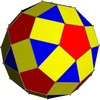 Convex hull |
 Great snub dodecicosidodecahedron |
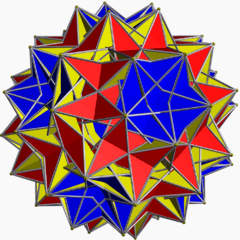 Great dirhombicosidodecahedron |
 Great disnub dirhombidodecahedron |
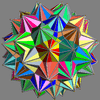 Compound of twenty octahedra |
 Compound of twenty tetrahemihexahedra |
Dual polyhedron

The dual of the great disnub dirhombidodecahedron is called a great disnub dirhombidodecacron. It is a nonconvex infinite isohedral polyhedron.
Like the visually identical great dirhombicosidodecacron in Magnus Wenninger's Dual Models, it is represented with intersecting infinite prisms passing through the model center, cut off at a certain point that is convenient for the maker. Wenninger suggested these figures are members of a new class of stellation polyhedra, called stellation to infinity. However, he also acknowledged that strictly speaking they are not polyhedra because their construction does not conform to the usual definitions.
Filling
There are different conventions about how to colour the faces of this polyhedron. Although the common way to fill in a polygon is to colour its whole interior, this can result in some filled regions hanging as membranes over empty space. That problem is avoided by another filling rule, in which orientable polyhedra are filled traditionally but non-orientable polyhedra have their faces filled with the modulo-2 method (only odd-density regions are filled in). In addition, overlapping regions of coplanar faces can cancel each other out.[1]
 Traditional filling |
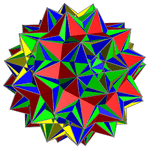 "Neo filling" |
See also
References
- Skilling, John (1975), "The complete set of uniform polyhedra", Philosophical Transactions of the Royal Society A, 278 (1278): 111–135, doi:10.1098/rsta.1975.0022.
- Weisstein, Eric W. "Great dirhombicosidodecahedron". MathWorld.
External links
- http://www.orchidpalms.com/polyhedra/uniform/skilling.htm
- http://www.georgehart.com/virtual-polyhedra/great_disnub_dirhombidodecahedron.html